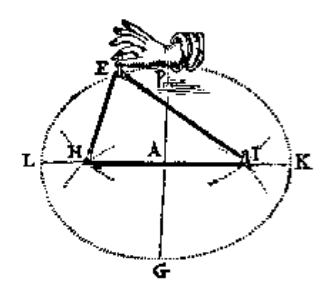How To Draw An Ellipse Using String Method
In my prior weblog posts, I've described how to construct ellipses using linkages, concentric circles, congruent triangles, and tangent circles. These are all groovy methods, but I think I got alee of myself: There's a elementary ellipse structure technique described in nearly every precalculus volume that I've bypassed in my excitement to show y'all the more than exotic approaches. Say hullo to the pins-and-string technique:

I don't think any introduction to ellipses is complete without students making their own physical model of the pins-and-string structure and experimenting with how the distance between Fane and F2 too equally the length of the string affects the shape of the ellipse. But I also call back there is value in edifice a Sketchpad version of the ellipse construction. Below is a pre-congenital Web Sketchpad model that your students can investigate. In my upcoming post, I'll evidence how y'all can construct this model from scratch using Web Sketchpad.
You lot'll find this construction, as well every bit many others, in my book Exploring Conic Sections with The Geometer'south Sketchpad.
The Spider web Sketchpad and Math Education Blog
Source: http://www.sineofthetimes.org/drawing-an-ellipse-with-pins-and-string/
Posted by: jacksonsentin2001.blogspot.com


0 Response to "How To Draw An Ellipse Using String Method"
Post a Comment